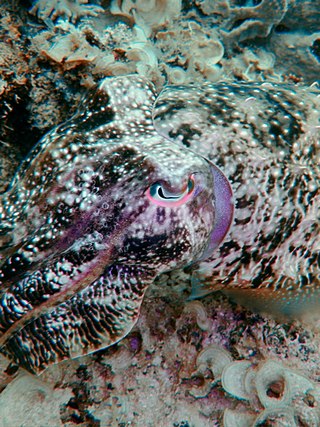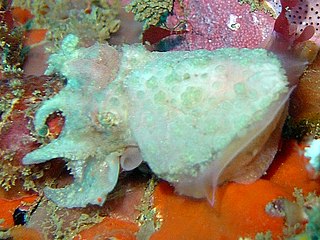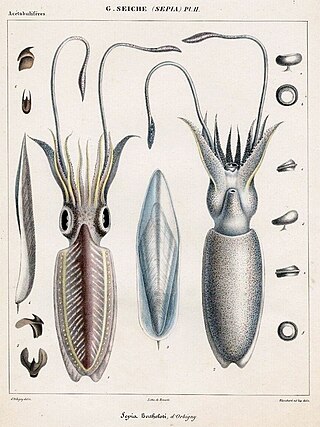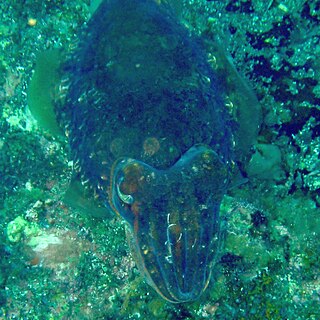
Sepia latimanus, also known as the broadclub cuttlefish, is widely distributed from the Andaman Sea, east to Fiji, and south to northern Australia. It is the most common cuttlefish species on coral reefs, living at a depth of up to 30 m.
Sepia baxteri is a species of cuttlefish native to the southwestern Pacific Ocean, specifically the waters around Lord Howe Island. It is known only from the type cuttlebones. Depth range is unknown.

Sepia bidhaia is a species of cuttlefish native to the southwestern Pacific Ocean, specifically the waters off the Great Barrier Reef. It lives at a depth of between 200 and 304 m.
Sepia chirotrema is a species of cuttlefish native to the southern Indo-Pacific, specifically from Investigator Strait, southern Australia to Dirk Hartog Island, western Australia. It lives at a depth of between 120 and 210 m.

Sepia mestus, also known as the reaper cuttlefish or red cuttlefish, is a species of cuttlefish native to the southwestern Pacific Ocean, specifically Escape Reef off Queensland to Murrays Beach off Jervis Bay. Reports of this species from China and Vietnam are now known to be misidentifications. S. mestus lives at a depth of between 0 and 22 m.

Sepia novaehollandiae is a species of cuttlefish native to the southern Indo-Pacific. Its natural range stretches from Shellharbour, New South Wales to North West Shelf in Western Australia. It lives at depths of between 15 and 348 m.
Sepia australis, the southern cuttlefish, is a species of cuttlefish which is found in the eastern South Atlantic Ocean and the western Indian Ocean off the coasts of Southern Africa, possibly extending into the waters off East Africa.
Sepia pulchra is a species of cuttlefish native to the southeastern Atlantic Ocean, specifically off the Cape Peninsula in South Africa. It lives at depths of between 15 and 50 m.
Sepia tenuipes is a species of cuttlefish native to the western Pacific Ocean. Its natural range covers the waters off eastern Honshū and the western Japan Sea to the south of Kyūshū, the East China Sea, and Korea. S. tenuipes lives at depths of 100 to 250 m.
Sepia thurstoni is a species of cuttlefish native to the Indian Ocean, specifically the waters off Chennai in India and off Negombo and Hambantota in Sri Lanka. It lives at depths of 20 to 40 m.

Sepia tuberculata is a species of cuttlefish native to South African waters from Melkbosstrand to Knysna. It belongs to the genus Sepia. It lives in very shallow water to a depth of 3 m. It is endemic.
Sepia vercoi is a species of cuttlefish native to the southeastern Indian Ocean, specifically the waters off Western Australia. It lives at depths of 76 to 201 m.

Sepia vermicularis, the patchwork cuttlefish.sometimes known as the common cuttlefish or ink-fish in South Africa, but the name common cuttlefish is more widely applied to Sepia officinalis. It is endemic to southern Africa.
Sepia zanzibarica, or the Zanzibar cuttlefish, is a species of cuttlefish native to the Indian Ocean.
Sepia braggi, the slender cuttlefish, is a species of cuttlefish native to the Indo-Pacific Ocean. It has been found in coastal waters of southern Australia. This species was first collected in South Australia by its namesake, William Lawrence Bragg. Sepia braggi was then described by Sir Joseph Cooke Verco in 1907.Sepia braggi is part of the subgenus Doratosepion which contains to 41 species of cuttlefish in total.

Sepia elegans, the elegant cuttlefish, is a species of cuttlefish in the family Sepiidae from the eastern Atlantic Ocean and the Mediterranean Sea. It is an important species for fisheries in some parts of the Mediterranean where its population may have suffered from overfishing.

Sepia bertheloti, the African cuttlefish, is a species of cuttlefish from the family Sepiidae which is found in the warmer waters of the eastern Atlantic Ocean off Africa.

Sepia orbignyana, the pink cuttlefish, is a species of small cuttlefish from the family Sepiidae. It is occurs in the temperate and tropical waters of the eastern Atlantic Ocean.

Sepia hierredda, the giant African cuttlefish, is a species of cuttlefish from the family Sepiidae, which was previously considered conspecific with the common cuttlefish Sepia officinalis. It is found along the western coast of Africa and is an important species to fisheries.
Sepia cultrata, commonly known as the knifebone cuttlefish or elongated cuttlefish, is a species of cuttlefish from the family Sepiidae endemic to the southern Indo-Pacific. It is a deepwater species found in subtropical and temperate Australian waters.










